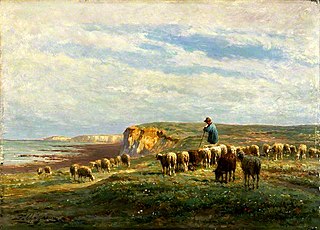Related Research Articles
In poetry, a hendecasyllable is a line of eleven syllables. The term may refer to several different poetic meters, the older of which are quantitative and used chiefly in classical poetry, and the newer of which are syllabic or accentual-syllabic and used in medieval and modern poetry.

"Jabberwocky" is a nonsense poem written by Lewis Carroll about the killing of a creature named "the Jabberwock". It was included in his 1871 novel Through the Looking-Glass, the sequel to Alice's Adventures in Wonderland (1865). The book tells of Alice's adventures within the back-to-front world of the Looking-Glass world.
Poetry is a form of literary art that uses aesthetic and often rhythmic qualities of language to evoke meanings in addition to, or in place of, literal or surface-level meanings. Any particular instance of poetry is called a poem and is written by a poet. Poets use a variety of techniques called poetic devices, such as assonance, alliteration, euphony and cacophony, onomatopoeia, rhythm, and sound symbolism, to produce musical or other artistic effects. Most written poems are formatted in verse: a series or stack of lines on a page, which follow a rhythmic or other deliberate structure. For this reason, verse has also become a synonym for poetry.
The pantoum is a poetic form derived from the pantun, a Malay verse form: specifically from the pantun berkait, a series of interwoven quatrains.
A sestina is a fixed verse form consisting of six stanzas of six lines each, normally followed by a three-line envoi. The words that end each line of the first stanza are used as line endings in each of the following stanzas, rotated in a set pattern.

A villanelle, also known as villanesque, is a nineteen-line poetic form consisting of five tercets followed by a quatrain. There are two refrains and two repeating rhymes, with the first and third lines of the first tercet repeated alternately at the end of each subsequent stanza until the last stanza, which includes both repeated lines. The villanelle is an example of a fixed verse form. The word derives from Latin, then Italian, and is related to the initial subject of the form being the pastoral.
A tercet is composed of three lines of poetry, forming a stanza or a complete poem.
A rhyme scheme is the pattern of rhymes at the end of each line of a poem or song. It is usually referred to by using letters to indicate which lines rhyme; lines designated with the same letter all rhyme with each other.
Marilyn Hacker is an American poet, translator and critic. She is Professor of English emerita at the City College of New York.
Terza rima is a rhyming verse form, in which the poem, or each poem-section, consists of tercets with an interlocking three-line rhyme scheme: The last word of the second line in one tercet provides the rhyme for the first and third lines in the tercet that follows. The poem or poem-section may have any number of lines, but it ends with either a single line or a couplet, which repeats the rhyme of the middle line of the previous tercet.
Envoi or envoy in poetry is used to describe:
The double dactyl is a verse form invented by Anthony Hecht and Paul Pascal in 1951.
New Formalism is a late 20th- and early 21st-century movement in American poetry that has promoted a return to metrical, rhymed verse and narrative poetry on the grounds that all three are necessary if American poetry is to compete with novels and regain its former popularity among the American people.
This is a glossary of poetry terms.
The volta is a rhetorical shift or dramatic change in thought and/or emotion. Turns are seen in all types of written poetry. In the last two decades, the volta has become conventionally used as a word for this, stemming supposedly from technique specific mostly to sonnets. Volta is not, in fact, a term used by many earlier critics when they address the idea of a turn in a poem, and they usually are not discussing the sonnet form. It is a common Italian word more often used of the idea of a time or an occasion than a turnabout or swerve.

Annie Finch is an American poet, critic, editor, translator, playwright, and performer and the editor of the first major anthology of literature about abortion. Her poetry is known for its often incantatory use of rhythm, meter, and poetic form and for its themes of feminism, witchcraft, goddesses, and earth-based spirituality. Her books include The Poetry Witch Little Book of Spells, Spells: New and Selected Poems, The Body of Poetry: Essays on Women, Form, and the Poetic Self, A Poet's Craft, Calendars, and Among the Goddesses.
June Thunder is a 28-line poem by Louis MacNeice. It was first published in book form in MacNeice's poetry collection The Earth Compels (1938). The poem begins with memories of idyllic summer days in the countryside - "the unenduring / Joys of a season" - before returning to the present and "impending thunder". June Thunder is written in a loose form of the sapphic stanza, with three lines set in falling rhythm followed by a shorter fourth line. The poem was anthologised in A New Anthology of Modern Verse 1920-1940 (1941), edited by Cecil Day-Lewis and L.A.G. Strong, and Penguin New Writing No. 2.

Catherine M. Chandler is a Canadian poet and translator, born in Queens, New York City and raised in Wilkes-Barre, Pennsylvania, emigrating to Canada in 1971. She received a Bachelor of Arts degree in French and Spanish from Wilkes University and a Master of Arts in Education from McGill University. She and her husband currently divide their time between their homes in Saint-Lazare-de-Vaudreuil, Québec, and Punta del Este, Uruguay.
The Discussion of Women's Poetry List-serv, known as Wom-Po, WOM-PO or WOMPO, is an international listserv devoted to the discussion of poetry by women. Wom-Po was started in December 1997 by poet Annie Finch. After being housed at Miami University, University of Southern Maine, and Nassau Community College, the listserv is currently housed on Google Groups. The majority of members are poets from the United States, the U.K. Australia, and New Zealand. Discussion on the listserv has sparked numerous conference panels, poetry readings, poetic collaborations, spin-off listservs such as the Mom-Po list, journal publications such as a collaborative Crown of sonnets published in Prairie Schooner in 2007, and an anthology, Letters to the World: Poems from the Wom-Po Listserv, published in 2008 by Red Hen Press.
Poetic devices are a form of literary device used in poetry. Poems are created out of poetic devices via a composite of: structural, grammatical, rhythmic, metrical, verbal, and visual elements. They are essential tools that a poet uses to create rhythm, enhance a poem's meaning, or intensify a mood or feeling.
References
- ↑ Collins, Billy (2002). "The Paradelle" . In Finch, Annie; Varnes, Kathrine (eds.). An exaltation of forms: Contemporary poets celebrate the diversity of their art. University of Michigan Press. p. 396. ISBN 0-472-06725-7.
- ↑ Theresa M. Welford (January 1, 2006). The Paradelle. Red Hen Press. ISBN 978-1-59709-023-0.